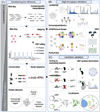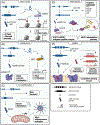Short open reading frame genes in innate immunity: from discovery to characterization
- PMID: 35965152
- PMCID: PMC10118063
- DOI: 10.1016/j.it.2022.07.005
Short open reading frame genes in innate immunity: from discovery to characterization
Abstract
Next-generation sequencing (NGS) technologies have greatly expanded the size of the known transcriptome. Many newly discovered transcripts are classified as long noncoding RNAs (lncRNAs) which are assumed to affect phenotype through sequence and structure and not via translated protein products despite the vast majority of them harboring short open reading frames (sORFs). Recent advances have demonstrated that the noncoding designation is incorrect in many cases and that sORF-encoded peptides (SEPs) translated from these transcripts are important contributors to diverse biological processes. Interest in SEPs is at an early stage and there is evidence for the existence of thousands of SEPs that are yet unstudied. We hope to pique interest in investigating this unexplored proteome by providing a discussion of SEP characterization generally and describing specific discoveries in innate immunity.
Keywords: Bifunctional genes; Innate immunity; Short open reading frames (sORFs).
Copyright © 2022 Elsevier Ltd. All rights reserved.
Conflict of interest statement
Declaration of interests S.C. is a paid consultant to NextRNA Therapeutics. No interests are declared by E.M.
Figures


Similar articles
-
Small Open Reading Frame-Encoded Micro-Peptides: An Emerging Protein World.Int J Mol Sci. 2023 Jun 23;24(13):10562. doi: 10.3390/ijms241310562. Int J Mol Sci. 2023. PMID: 37445739 Free PMC article. Review.
-
Peptidomic discovery of short open reading frame-encoded peptides in human cells.Nat Chem Biol. 2013 Jan;9(1):59-64. doi: 10.1038/nchembio.1120. Epub 2012 Nov 18. Nat Chem Biol. 2013. PMID: 23160002 Free PMC article.
-
Mining for missed sORF-encoded peptides.Expert Rev Proteomics. 2019 Mar;16(3):257-266. doi: 10.1080/14789450.2019.1571919. Epub 2019 Feb 13. Expert Rev Proteomics. 2019. PMID: 30669886 Review.
-
Identification and characterization of sORF-encoded polypeptides.Crit Rev Biochem Mol Biol. 2015 Mar-Apr;50(2):134-41. doi: 10.3109/10409238.2015.1016215. Epub 2015 Apr 10. Crit Rev Biochem Mol Biol. 2015. PMID: 25857697 Free PMC article. Review.
-
Functions of animal microRNA-encoded peptides: the race is on!EMBO Rep. 2022 May 4;23(5):e54789. doi: 10.15252/embr.202254789. Epub 2022 Mar 28. EMBO Rep. 2022. PMID: 35343609 Free PMC article.
Cited by
-
LncRNA-encoded peptides in cancer.J Hematol Oncol. 2024 Aug 12;17(1):66. doi: 10.1186/s13045-024-01591-0. J Hematol Oncol. 2024. PMID: 39135098 Free PMC article. Review.
-
Small but mighty: the rise of microprotein biology in neuroscience.Front Mol Neurosci. 2024 May 14;17:1386219. doi: 10.3389/fnmol.2024.1386219. eCollection 2024. Front Mol Neurosci. 2024. PMID: 38807924 Free PMC article.
-
Biophysical characterization of high-confidence, small human proteins.bioRxiv [Preprint]. 2024 Apr 15:2024.04.12.589296. doi: 10.1101/2024.04.12.589296. bioRxiv. 2024. Update in: Biophys Rep (N Y). 2024 Sep 11;4(3):100167. doi: 10.1016/j.bpr.2024.100167. PMID: 38659920 Free PMC article. Updated. Preprint.
-
The sORF-Encoded Peptides, ATP Synthase Subunits, Facilitate WSSV Duplication in Shrimp.Viruses. 2022 Nov 4;14(11):2449. doi: 10.3390/v14112449. Viruses. 2022. PMID: 36366547 Free PMC article.
-
Disruption of the Novel Small Protein RBR7 Leads to Enhanced Plant Resistance to Blast Disease.Rice (N Y). 2023 Sep 21;16(1):42. doi: 10.1186/s12284-023-00660-1. Rice (N Y). 2023. PMID: 37733139 Free PMC article.
References
-
- Goffeau A et al. (1996) Life with 6000 genes. Science 274, 563–567 - PubMed
-
- Couso J-P and Patraquim P (2017) Classification and function of small open reading frames. Nat. Rev. Mol. Cell Biol 18, 575–589 - PubMed
-
- Li X et al. (2018) The biogenesis, functions, and challenges of circular RNAs. Mol. Cell 71, 428–442 - PubMed

